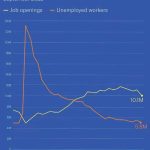With the US facing labour shortages, supply chain issues and even talk of a recession, several businesses in the overhead crane industry describe what they are doing to help not only their customers, but themselves too. Tony Rock reports.
The US is suffering a labour shortage. According to the latest data from the country’s Chamber of Commerce, which represents some three million businesses, there are more than ten million job openings in the US – but only 5.7 million unemployed workers.
Speaking about the issue in an article on the organisation’s website, Stephanie Ferguson, the US Chamber of Commerce’s director, global employment policy and special initiatives, says: “We hear every day from our member companies – of every size and industry, across nearly every state – they’re facing unprecedented challenges trying to find enough workers to fill open jobs.”
Ferguson says several factors have come together to cause the ongoing shortage. At the top of the list is Covid-19.
“The pandemic caused a major disruption in America’s labour force – something many have referred to as ‘The Great Resignation’,” she says. Put simply, Covid-19 caused many people to reevaluate their lives, and either retire, cut back on their hours, take time out – perhaps in order to acquire new skills or education – or change how and where they worked.
“We have nearly three million fewer Americans participating in the labour force today compared to February of 2020 [the start of the pandemic],” adds Ferguson.
Other factors at play include having to stay at home to care for children or other family members, looking for higher salaries, and ill health – for example, a recent US Department of Health and Human Services report said that while estimates vary, research suggests that between 5% and 30% “of those who had Covid-19 may have long Covid symptoms, and roughly one million people are out of the workforce at any given time” due to the condition, in which effects of the disease continue for several weeks or months.
What can firms do to counteract a labour shortage, and the impact that has not only on their remaining employees in terms of a potential increased workload, but also on their ability to meet their business targets?
Rob Beightol, director of marketing at overhead crane firm Gorbel, says that companies that are continuing to struggle to attract and retain skilled labour for their production work are looking for ways to “do more with fewer personnel and are relying on crane and hoist companies to provide solutions to enable them to do this”.
Beightol says this might include adding additional lifting and positioning equipment whenever manual work has been the norm; ensuring that lifting and positioning causes minimal strain on workers in order to protect them from injuries and keep them performing the job; moving from a multiperson operation to a single person set-up – allowing for redeployment of personnel across the facility; or changing the set-up of work cells (an arrangement of machines, personnel and materials required to manufacture a product) or lines.



没有评论:
发表评论